Smoking in the United States military
Smoking in the United States military has been observed in previous wars, but smoking's close association with the United States military started in World War I when tobacco companies began to target military personnel through the distribution of cigarettes to servicemen and the eventual inclusion of cigarettes into rations. Although the military has attempted to implement tobacco control initiatives, the association between smoking and military personnel has persisted to the present day as smoking rates remain high, despite declines in civilian rates. Such high rates have led to questions about the effect of smoking from the apparent health risks to troop readiness and training costs.
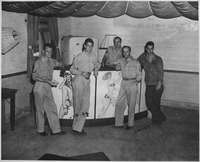
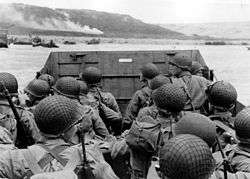
Smoking in the US military from 1917 to 1975
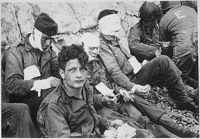
With the entrance of the United States into World War I in 1917, cigarette use increased dramatically among United States military personnel as they were targeted by tobacco companies which touted cigarettes as a way for soldiers to psychologically escape from their current circumstances, boosting overall troop morale.[1][2] Cigarettes became so integrated into life on the battlefield that these symbols of pleasure and comfort were also used as a form of currency.[2] Although cigarettes had been regarded as a physical and moral hazard by early anti-tobacco movements around this time, by 1918, previously anti-cigarette organizations and the military began supporting efforts to distribute cigarettes to troops. The New York Times garnered support for these efforts by stating that cigarettes "lighten[ed] the inevitable hardships of war", and another popular periodical described cigarettes as the "last and only solace of the wounded." [1][3] With the rise of World War II, tobacco companies continued to foster this culture of wartime smoking by sending free cigarettes to troops and supporting the inclusion of cigarettes into the soldiers' rations. Advertisements also encouraged citizens back home to support the troops by sending cigarettes.[2][4] In 1965, first during the U.S. Army’s Basic Training Course & later in Pre-Airborne Infantry Training, while being allowed a break from P.T., or during a long march, it was commonplace for a Drill Sergeant to say "smoke ’em if you got ’em, do pushups if you don’t". Non-smoking soldiers would quickly "bum" a cigarette from a friend & they too would soon be smokers.[4] Despite mounting evidence in the 1950s of the adverse health effects of smoking and tobacco use, the military continued to include cigarettes in rations until 1975.[5]
Attempts at tobacco control initiatives
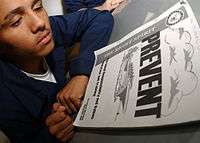
With the scientific data about the health risks of smoking and information about the effect of smoking on troop readiness, in 1975, the United States Department of Defense discontinued the inclusion of cigarettes in K-rations and C-rations. By 1978, the Department of Defense had implemented basic smoking regulations, including the designation of smoking and nonsmoking areas.[5] In 1985, the Department of Defense conducted a study that revealed that smoking rates of military personnel (47%) were significantly higher than that of US civilians (30%) and concluded that smoking had a negative effect on troop readiness.[6] The report also cited an estimated tobacco-related healthcare costs as high as $209.9 million, and recommended potential methods to curb smoking in the military, including the elimination of tobacco products from stores, raising tobacco prices to civilian levels, and the implementation of an educational program to discourage smoking.[5][6] In 1986, the DoD Directive 1010.10 was issued by Secretary of Defense Caspar Weinberger, who announced, "an intense anti-smoking campaign…at all levels of all Services." [6] It established a policy on smoking and other health risk behaviors such as alcohol consumption. The policy banned the use of tobacco during basic training, increased the number of designated nonsmoking areas, and prohibited health care providers from smoking on duty. The goal of the policy was to reduce all tobacco use rates to below that of civilians, and to reduce personnel and active duty rates from 52% to 25% by 1990.[6] In 1992, the DeCA Directive 40-13 policy prohibited commissaries and exchanges from participating with promotions by tobacco manufacturers directed specifically at military personnel, and required commissaries to stock cigarettes in the back. In 1993, the USS Theodore Roosevelt (CVN-71) became the first smoke-free Navy ship.[7] By 1994, the Department of Defense had implemented Directive 1010.15 which banned smoking in workplaces, designated outdoor smoking areas, and created the precursor of an education program that sought to distribute information to new personnel on the health effects of smoking and to encourage smokers to quit. Executive Order 13508 in 1997 banned smoking in all government-owned, rented, or leased interior spaces, but the Department of Defense approved a three-year phase-in period for their facilities and eventually implemented the ban on December 7, 2002.[5] Despite these attempts, by 1988, the smoking rate had only decreased to 42% and far exceeded the rate of civilians.[6] And although prevalence did decrease to 29.9% from 1980 to 1998, it has increased since then and appears to still be increasing.[3]
Tobacco industry's response
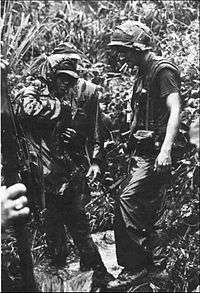
Realizing the opportunities of a worldwide military market due to the young demographics of military personnel and the smoking initiation associated with new recruits, the Tobacco Institute, which served as the tobacco industry's lobbying organization, and Philip Morris perceived these new tobacco control initiatives as a threat and conceived strategies to circumvent the government policies. Another incentive for the tobacco industry to protect its military market was the recognized phenomenon that consumer product preferences developed during years serving in the military would later translate into civilian market profits as service members left the military or retired.[5] After the implementation of Directive 1010.10 in 1986, the Tobacco Institute and Philip Morris immediately began seeking the support of tobacco-friendly politicians against the policy, citing that the policy would have a negative impact on military recruitment, retention, and morale. Furthermore, letters sent to Secretary of Defense Weinberger from politicians invoked rhetoric about the infringement of "personal rights" and "an individual's right to smoke." Such political lobbying helped to limit the implementation and the further extension of Directive 1010.10.[6]
Although the Department of Defense had discontinued the practice of free distribution of cigarettes during wartime, tobacco companies began campaigns during the Gulf War (1990-1991) to distribute free cigarettes to soldiers stationed in Saudi Arabia, but would eventually be rebuffed by the Department of Defense. Regardless, Philip Morris then began a campaign of sales through direct mail, and extended promotions to deployed troops that included the delivery of branded goods such as playing cards and cup cozies. Curiously enough, the military actually assisted the tobacco companies in delivering shipments to military stores in Saudi Arabia at government expense. Another controversy arose when it was discovered that RJ Reynolds had placed their company name on the front and a Camel advertisement on the back of donated magazines from Operation Desert News, a civilian project to bring magazines to the troops. In spite of the initial rejection by the Department of Defense due to the advertisement, constant pressure from RJ Reynolds and politicians allowed the magazines to be delivered with the advertisement at government expense, violating military policy that forbade tobacco-branded promotions directed at military personnel.[3] In addition, Philip Morris focused on promoting the Marlboro brand with the goal of fostering corporate good will by initiating the "Marlboro holiday voice card" program.[3][5] Held on 10 military bases, they invited family of deployed personnel to record a message for onto a chip inserted into a greeting card, and later allowed bases to extend the recording of such messages to the public. Despite being in violation of Department of Defense policy concerning tobacco-branded programs directed at military personnel, Philip Morris had received permission to carry out the program from the Defense Logistics Agency, the Morale, Welfare and Recreation headquarters of the services, and base commanders. Furthermore, after troops were withdrawn from the conflict in 1991, tobacco companies sponsored "Welcome Home" events for returning troops featuring extensive brand promotion.[3] Although the Department of Defense had enacted policies to reduce tobacco use amongst personnel, the successful efforts of tobacco companies as well as the cultural factors of smoking in the military have produced a mixed message of tobacco promotion and reduction to military personnel.
Present-day smoking in the US military

_shares_info.jpg)
In 2005, the smoking rate of military personnel was found to be 32.2%, compared to the civilian rate of 21%.[3] The higher smoking rate suggests that certain aspects of military may foster smoking. These factors include peer influence, combat stress, boredom, and easy access to cheap tobacco products.[8] Another factor that may lead to increased tobacco use is deployment. One study found that among nonsmokers, smoking initiation was observed in 1.3% of nondeployed personnel while 2.3% were observed in deployed personnel. Among past smokers, resumption of smoking occurred in 28.7% of non deployed personnel and 39.4% of deployed personnel, while smoking increased 44% among the former and 57% among the latter.[9] US troops in Iraq and Afghanistan have been reported to smoke at twice the rate of other Americans.[10] Even after leaving the service, many veterans continue to smoke as the prevalence of smoking among veterans has been reported to be 27% during 2003 to 2007, and military smoking is strongly associated with increased lifelong cigarette consumption.[11] Such high levels of smoking have led to significant costs to the Department of Defense. The costs of smoking among US military health care system beneficiaries have been estimated to be more than $900 million per year in 1995, with $584 million in direct health care costs and $346 million in lost productivity among active duty personnel.[11] Suicide, which accounts for 13% of fatalities in the military, has also been tied to smoking, as the risk of suicide among military men was found to increase significantly with the number of cigarettes smoked daily.[12] Smoking also affects training costs as smokers are more likely to be discharged during training, and are associated with $18 million per year in excess training costs for the US Air Force, and over $130 million per year for all service branches.[13]
Note that the figures regarding smoking and suicide and manpower losses during training may represent more of a symptomatic relationship than a causative one. Many discharges during basic training result from a series of minor infractions, punished administratively as opposed to by courts-martial, which are seen as an indicator that the trainee cannot or will not adjust to military life, rather than any single incident or serious violation of regulations. With smoking now prohibited in basic training, being caught smoking, and perhaps even being caught in the possession of cigarettes, is such an offense which smokers are obviously at risk for while non smokers are not. Regarding suicide, the figures showing increased rates of smoking and resumption of smoking among those deployed indicates that smoking may be a reaction to and indicator or increased stress, and a person who is potentially suicidal would obviously be under a more than typical degree of stress, so increased smoking may be an indicator of that excessive stress rather than a cause for increased risk of suicide. Also, a higher rate of smoking among those discharged during training may also be indicative of individuals for whom training is more than normally stressful, and such persons would likely experience more difficulty in successfully completing training than one who is not unusually (compared to his/her peers) stressed by it.
In 2008 unauthorized smoking and improper storage of chemicals caused major damage to USS George Washington (CVN-73).[14]
The Department of Defense hoped to lower rates of tobacco use to 12% by the end of 2010.[6] To achieve their goal, Pentagon health experts urged then-Defense Secretary Robert Gates to ban the use of tobacco by troops and end its sale on military property.[15] The Navy implemented a ban on smoking in submarines by the end of 2010 – highlighting one of the last loopholes in the indoor smoking ban imposed in 1994.[16]
See also
References
- Brandt, Allan M. 2007. The Cigarette Century: The Rise, Fall, and Deadly Persistence of the Product that Defined America. New York: Basic Books, pp. 50–53
- Goodman, J. (Ed.). (2005). Tobacco history and culture: An encyclopedia. Detroit: Scribner's.
- Smith, Elizabeth A.; Malone, Ruth E. (2009). "'Everywhere the Soldier Will Be': Wartime Tobacco Promotion in the US Military". American Journal of Public Health. 99: 1595–1602. doi:10.2105/ajph.2008.152983. PMC 2724442. PMID 19608945.
- "Stahl, R."
- Joseph, Anne M.; et al. (2005). "The Cigarette Manufacturers' Efforts to Promote Tobacco to the U.S. Military". Military Medicine. 170: 874–880.
- Arvey, Sarah R.; Malone, Ruth E. (2008). "Advance and Retreat: Tobacco Control Policy in the U.S. Military". Military Medicine. 173: 985–991. doi:10.7205/milmed.173.10.985. PMC 2794241. PMID 19160617.
- Offen, Naphtali; Arvey, Sarah R.; Smith, Elizabeth A.; Malone, Ruth E. (March 2011). "Forcing the Navy to Sell Cigarettes on Ships: How the Tobacco Industry and Politicians Torpedoed Navy Tobacco Control". American Journal of Public Health. 101 (3): 404–411. doi:10.2105/ajph.2010.196329. PMC 3036696. PMID 21233435.
- Nelson, Jenenne P.; Pederson, Linda L. (2008). "Military tobacco use: A synthesis of the literature on prevalence, factors related to use, and cessation interventions". Nicotine & Tobacco Research. 10: 775–790. doi:10.1080/14622200802027123.
- Smith, Besa; et al. (2008). "Cigarette Smoking and Military Deployment". American Journal of Preventive Medicine. 35: 539–546. doi:10.1016/j.amepre.2008.07.009.
- Kirby, A.; et al. (2008). "Smoking in help-seeking veterans with PTSD returning from Afghanistan and Iraq". Addict Behav. 33: 1448–53. doi:10.1016/j.addbeh.2008.05.007. PMC 2556875. PMID 18571871.
- Brown, David W (2010). "Smoking prevalence among US veterans". J Gen Int Med. 25: 147–149. doi:10.1007/s11606-009-1160-0. PMC 2837499. PMID 19894079.
- Miller, Matthew; et al. (2000). "Cigarette Smoking and Suicide: A Prospective Study of 300,000 Male Activeduty Army Soldiers". American Journal of Epidemiology. 151: 1060–63.
- Klesges Robert, C; Haddock, Keith C.; Chang, Cyril F.; et al. (2001). "The association of smoking and the cost of military training". Tobacco Control. 10: 43–47. doi:10.1136/tc.10.1.43. PMC 1764000. PMID 11226360.
- "USS George Washington Investigation Complete, Senior Leadership Relieved". www.navy.mil. Commander Naval Air Forces Public Affairs. 30 July 2014. Retrieved 2 October 2014.
- Zoroya, Greg (2009-07-09). "Ban on tobacco urged in military". USA Today. Retrieved 12 June 2012.
- Bynum, Russ (2010-04-28). "No butts about it: Navy subs to ban smoking". msnbc. Associated Press. Retrieved 12 June 2012.
External links
| Wikimedia Commons has media related to Smoking in the United States military. |
- Defense.gov News Article: Report Urges Timeline for Tobacco-free Military. WASHINGTON, July 10, 2009.